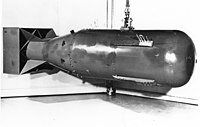
Photo from wikipedia
This study uses multiple sea surface temperature (SST) datasets to perform a parallel comparison of three super El Niños and their effects on the stratosphere. The results show that, different… Click to show full abstract
This study uses multiple sea surface temperature (SST) datasets to perform a parallel comparison of three super El Niños and their effects on the stratosphere. The results show that, different from ordinary El Niños, warm SST anomalies appear earliest in the western tropical Pacific and precede the super El Niño peak by more than 18 months. In the previous winter, relative to the mature phase of El Niño, as a precursor, North Pacific Oscillation-like circulation anomalies are observed. A Pacific–North America (PNA) teleconnection appears in the extratropical troposphere during the mature phase, in spite of the subtle differences between the intensities, as well as the zonal position, of the PNA lobes. Related to the negative rainfall response over the tropical Indian Ocean, the PNA teleconnection in the winter of 1997/98 is the strongest among the three super El Niños. The northern winter stratosphere shows large anomalies in the polar cap temperature and the circumpolar westerly, if the interferences from other factors are linearly filtered from the circulation data. Associated with the positive PNA response in a super El Niño winter, positive polar cap temperature anomalies and circumpolar easterly anomalies, though different in timing, are also observed in the mature winters of the three super El Niños. The stratospheric polar vortex in the next winter relative to the 1982/83 and 1997/98 events is also anomalously weaker and warmer, and the stratospheric circulation conditions remain to be seen in the coming winter following the mature phase of the 2015/16 event.摘要本文使用多套海温资料(COBE, ERSST和HadISST), 海洋资料GODAS和大气再分析资料NCEP2, 比较研究了历史上三次超级 El Niño 事件(1982/83, 1997/98和2015/16)的演变特征, 同时关注了超级 El Niño 对北半球冬季平流层的可能影响. 三套海温数据一致表明, 超级 El Niño 事件与普通强度的 El Niño 事件明显不同, 即暖海温异常最早出现在热带西太平洋且超前超级 El Niño 事件达 18 个月之久. 作为超级 El Niño 事件的另一个先兆信号, 即北太平洋涛动(NPO)超前超级 El Niño 事件成熟位相达一年之久, NPO出现在超级 El Niño 成熟位相的前一年冬季. 发展成熟的超级 El Niño有利于热带外太平洋–北美遥相关(PNA)正位相维持. 值得注意的是, 三次超级 El Niño 成熟位相期间的 PNA 强度和纬向位置不尽相同. 1997/98年冬季PNA强度明显强于 1982/83和2015/16年, 这与1997/98年冬季印度洋降水明显偏少有关. 从再分析资料中滤除影响热带外平流层年际变化的 QBO, 热带印度洋热力异常和太阳循环等强迫因子后, 我们依然发现超级 El Niño 同年冬季平流层极冠区明显偏暖, 且绕极西风明显减弱. 三次事件的共同点在于, 伴随热带外 PNA响应, 热带外上传至平流层的行星波波动明显增多; 不同之处在于极涡异常偏弱偏暖的月份各不相同, 即 1982/83 和 2015/16 极涡偏暖时间明显偏向晚冬至春季. 异常偏暖偏弱的平流层极涡不仅发生在超级 El Niño 事件成熟位相冬季(尤其是晚冬), 而且还出现在 1982/83 和 1997/98 两次超级 El Niño 的次年冬季. 2015/16 超级 El Niño 是否也会对滞后一年的冬季平流层产生显著影响, 这有待进一步研究.
Journal Title: Advances in Atmospheric Sciences
Year Published: 2017
Link to full text (if available)
Share on Social Media: Sign Up to like & get
recommendations!